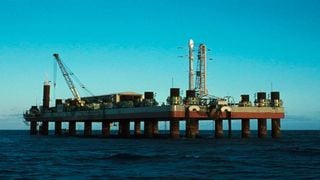
The Luigi Broglio Space Center located near Malindi is an Italian Space Agency Spaceport.
| File | Nation Media GroupKenya@60
Premium
When Kenyans were space explorers and the forgotten Malindi space station
The April launch of Taifa-1, Kenya's first operational Earth observation satellite, aboard a SpaceX Falcon 9 rocket from the Vandenberg Space Centre in the US, put a powerful spotlight on Kenya's role in space exploration and research.
And it all began in the 1960s when Italian civil engineer Professor Luigi Brogolio had a dream of an Italian space station on the equator from where Italians would go to the moon.
The equator is considered one of the best platforms for launching satellites.
It was from this sea-born station, also named the Luigi Broglio Space Centre after the professor, that UHURU, a small satellite, was first launched on 12 December 1970 to survey the sky for X-ray astronomy, a world first at the time.
For this achievement, Riccardo Giacconi, one of the designers of the Uhuru satellite, was awarded the Nobel Prize in Physics in 2002, together with others, for their role in understanding the stars and planets.
The Malindi Centre was established in 1962 and has been used to launch sounding rockets and archive satellite data. It has part of its facility at sea, on a former oil platform, and part on land.
It is also used for satellite tracking and telemetry services, communications services, data acquisition, surveillance and navigation.
There has been a push for Kenya to benefit from the facility to help the local community, although it was not intended to be a programme-generating project based on old agreements between Kenya and Italy.
It is currently run by the Italian and Kenyan space agencies, with the last launch taking place in 1988 and at least 27 launches, according to Nasa.
In March, Italian President Sergio Mattarella visited the facility in Kilifi County after holding talks with President William Ruto in Nairobi.
“Further, we agreed that our bilateral cooperation should enhance mutual benefit of the Luigi Broglio Space Centre in Malindi centre’s outputs in scientific and technological research, for sustainable development in Kenya,” Dr Ruto said.
On his part, President Mattarella appreciated the work of the two Space Agencies for their synergy, saying this is a testament to the strong ties and partnership that Kenya and Italy enjoy.
Defense Cabinet Secretary Aden Duale said the centre is a ‘special diplomatic and strategic centre and that Kenya intends to leverage human capacity building to achieve her aspirations as an emerging space-faring nation.’
He lauded the establishment of the International Centre for Space Education domiciled at the facility mandated to train engineers and other professionals in ground station and space operations.
“We hope the training will also extend to other competencies including the development of applications of earth observation,” said the CS.
Kilifi Governor Gideon Mung’aro expressed the need for the county government to benefit from the Luigi Broglio Space Center (BSC), an Italian Space Agency (ASI) Spaceport in Malindi.
Speaking in a meeting with the Italian President, Mr Sergio Mattarella, when he toured the Luigi Broglio Space Center (BSC), Governor Mung’aro said they had noted that the county government was not accessing a lot of benefits from the facility.
“My appeal is to the Kenyan and Italian governments that this space station must benefit both the Italians and Kenyans, especially the county government of Kilifi. This space station has been here for a long time but very little has been done since when the facility started. There have been many promises from when I was a Mayor of Malindi and a Member of Parliament,” he said during the visit.
That by Kenya sending a major satellite into space is no big mean fete, the country has now joined the elite club of nations that have made tremendous progress in space exploration.





